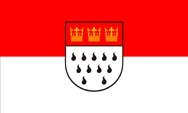Köln |
|
|
|
| Übersicht – Contents: | |
Köln |
|
|
|
| Übersicht – Contents: | |
Flaggen – Flags: |
|
 |
Flagge Erzbistum Köln – flag Archbishopric of Cologne |
 |
Flagge der Stadt Köln – flag of Cologne City |
| Quelle/Source: nach/by: Wikipedia (D) | |
|
|
|
Bedeutung/Ursprung der Flagge – Meaning/Origin of the Flag: |
|
| Die Flagge des Erzbistums Köln ist eine Wappenflagge. Sie zeigt das Bild des Wappenschilds des Erzbistums Köln, ein schwarzes Kreuz auf Weiß (Silber). | The flag of the Archbishopric of Cologne is a scutcheon-flag. It shows the image of the blazon of the Archbishopric of Cologne, a black cross on white (silver). |
| Quelle/Source: Wikipedia (D) | |
| Landkarte – Map: |
|
Zahlen und Fakten – Numbers and Facts: |
|
|
|
|
|
Geschichte: |
|
Antike
· Besiedlung durch germanische Stämme (Eburonen, Aduatuker, Ubier und
Guberner) 58 bis 51 v.Chr. · das Gebiet wird durch Römische Truppen erobert, zur Provinz Germania Inferior, eine Ubier-Siedlung am Rhein erhält den lateinischen Namen Oppidum Ubiorum (Ubiersiedlung) 50 n.Chr. · Oppidum Ubiorum erhält das Stadtrecht von Kaiserin Agrippina, der Gattin von Kaiser Claudius; ihr zu Ehren wird die Stadt wenig später in Colonia Claudia Ara Agrippinensium (kurz: Colonia Agrippina, später Köln) umbenannt 2. Jahrhundert · Köln wird Bistum (Sitz eines Bischofs) 253 · Invasionen der Franken und Ripuarier 395 · bei der Teilung des Römischen Reiches kommt das Gebiet Köln an das Weströmische Reich 455 · Eroberung durch die Franken 481 · das Gebiet Köln kommt an das Frankenreich 785 · Köln wird Erzbistum (auch Erzdiözese genannt, Sitz eines Erzbischofs, erstes Bistum einer katholischen Kirchenprovinz in der der Erzbischof residiert) 953 · Otto der Große überträgt seinem Bruder Erzbischof Brun die Stadt und das Erzbistum Köln zusammen mit dem Herzogtum Lothringen als (teilweise) weltlichen Besitz. Das Erzbistum wird so zusätzlich zu einer weltlichen Gebietskörperschaft 13. Jahrhundert · die Erzbischöfe von Köln werden zu Kurfürsten (zur Königswahl berechtigte Fürsten) 1794 · Invasion der französischen Revolutionsarmee, das Erzbistum verliert seine Selbstständigkeit 1801 · das Erzbistum und Kurfürstentum wird aufgelöst, alle linksrheinischen Gebiete werden an Frankreich abgetreten und von diesem einverleibt 1803 · Reichsdeputationshauptschluss, die rechtsrheinischen Gebiete werden auf die Herzogtümer Nassau und Hessen-Darmstadt und die Grafschaft Wied-Runkel aufgeteilt 1806 · Ende des Heiligen Römischen Reiches Deutscher Nation 1815 · Wiener Kongress, fast alle Gebiete des ehemaligen Erzbistums Köln kommen an Preußen, zur Provinz Jülich-Kleve-Berg (ab 1822 zur Rheinprovinz) oder zur Provinz Westfalen 1821 · Wiederherstellung des Erzbistums als rein geistliches Verwaltungsgebiet 1947 · der Staat Preußen wird durch die Alliierten eliminiert, die Rheinprovinz und Westfalen werden den neu geschaffenen Ländern Nordrhein-Westfalen und Rheinland-Pfalz angeschlossen |
History: |
|
Ancient
· settlement by Germanic tribes (Eburones, Aduatuci, Ubii and Guberner) 58–51 B.C. · The area was conquered by Roman troops, to the province of Germania Inferior, to an Ubii settlement on the Rhine was given the Latin name Oppidum Ubiorum (lace of the Ubii Tribe) 50 A.D. · Oppidum Ubiorum receives its town charter by the Empress Agrippina, the wife of Emperor Claudius, to honor her, the town was a little later renamed to "Colonia Claudia Ara Agrippinensium" (short: Colonia Agrippina, later Cologne) 2nd century · Diocese of Cologne (the seat of a bishop) 253 · invasions of the Franks and Ripuarians 395 · at the division of the Roman Empire the Cologne area came to the West Roman Empire 455 · conquest by the Franks 481 · the region comes to the Frankish Empire 785 · Cologne becomes archdiocese (also called archbishopric, the seat of an archbishop, a first diocese of the Catholic church in a province of the archbishop resides) 953 · Otto the Great gives the city and the archbishopric of Cologne and the Duchy of Lorraine to his brother Brun as partially worldly possessions. The archbishopric becomes in this way in addition a local secular authority 13th century · the Archbishops of Cologne become electors (for the royal election legitimated prince) 1794 · invasion of the French revolutionary army, the archbishopric loses its independence 1801 · the Archbishopric and Electorate becomes dissolved, all the left-bank territories ceded to France and incorporated by this 1803 · German Mediatisation (Reichsdeputationshauptschluss), the right-bank areas become divided between the Duchies of Nassau and Hesse-Darmstadt, and the County of Wied-Runkel 1806 · end of the Holy Roman Empire of German Nation 1815 · Congress of Vienna, nearly all the territories of the former Archbishopric of Cologne come to Prussia, to the province of Jülich-Kleve-Berg (from 1822 Rhine Province) or to the Province of Westfalia 1821 · restoration of the archbishopric of as purely sacral administrative region 1947 · the state of Prussia becomes eliminated by the Allies, the Rhineland and Westfalia become connected to the newly created States of North Rhine-Westfalia and Rhineland-Palatinate |
| Quellen: Wikipedia (D), Atlas zur Geschichte, Discovery '97 |
Ursprung des Landesnamens – Origin of the Country's Name: |
|
| Das Erzbistum und Kurfürstentum Köln wurde nach der Stadt Köln benannt, dem Sitz der Erzbischöfe. Zu Beginn der römischen Herrschaft hieß die Siedlung "Oppidum Ubiorum", was übersetzt "Ubiersiedlung" heißt. Im Jahre 50 n.Chr. wurde der Siedlung auf Betreiben der Kaiserin Agrippina, der Gattin von Kaiser Claudius, das Stadtrecht verliehen. Wenig später wurde sie deswegen in "Colonia Claudia Ara Agrippinensium" umbenannt, was als "Ansiedlung Claudia, Opferstätte der Agrippiner" übersetzt werden kann. Die Kurzform "Colonia Agrippina" wurde im Lauf der Zeit noch zu "Colonia" verkürzt, was über Jahre im Deutschen zu "Coellen, Cöllen, Cölln" und später "Cöln" gewandelt wurde. Ab 1919 war die Schreibweise "Köln" verbindlich. Als eine andere Form des Namens blieb "Cologne" erhalten, das im Französischen und Englischen als Name der Stadt verwendet wird. | The Archdiocese and Electorate of Cologne, was named after the city of Cologne, the seat of the archbishops. At the beginning of Roman rule the settlement was called "Oppidum Ubiorum", which translated means "Place of the Ubii Tribe". In the year 50 A.D. the settlement was awarded at the instigation of the Empress Agrippina – the wife of Emperor Claudius – with the city law. A little later, it was therefore renamed in "Colonia Claudia Ara Agrippinensium", what can be translated with "Settlement Claudia, the place of sacrifice of the Agrippinenses". The short form "Colonia Agrippina" became shortened through the passage of time to "Colonia", what in German became changed though the years to "Coellen, Cöllen, Cölln" and later "Cöln". From 1919 the spelling as "Köln" was obligatory. As another form of the name remained "Cologne", which in French and English is used as the name of the city. |
| Quelle/Source: Wikipedia (D) | |